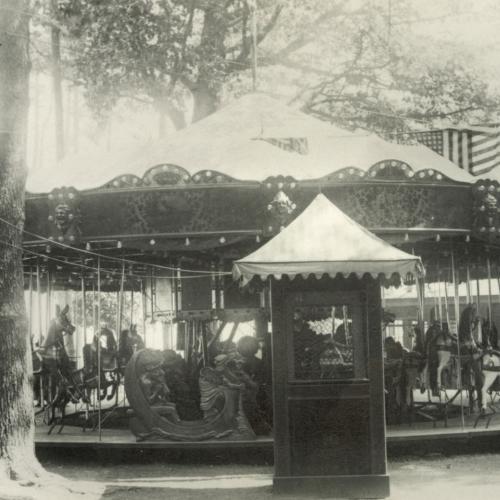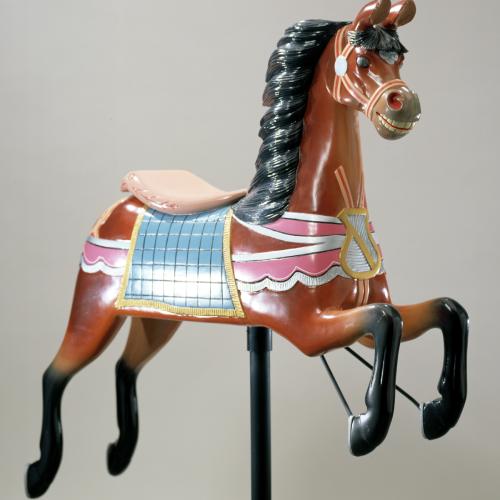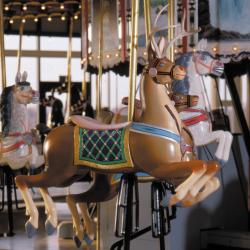
The New York State Museum Carousel
Tuesday–Sunday, 11 am–4 pm
This full-sized carousel, made circa 1914 by the Herschell-Spillman Company of North Tonawanda, New York, represents the heart and soul of amusement rides at the turn of the 20th century. The State Museum is fortunate to have been able to play a role in the preservation—and continued enjoyment—of this example of American folk art and memento of American childhood.
The Carousel is not only an amusement park ride—it’s a piece of history.
To preserve this working artifact, we require a minimum of 10 riders on the Carousel.
With riders evenly distributed, the Carousel can maintain the weighted balance needed to operate smoothly. This helps protect its working parts now, and for generations to come.
Thank you for your patience and partnership in preserving this century-old treasure.
About the Carousel
The carousel originally featured forty animals, including 36 horses of three sizes and in various poses, along with two donkeys and two deer. The substitution of other animals for horses was a mark of distinction among carousels, as was the "Neptune's Chariot," a decoratively carved seat. A rocking carriage and a spinning “Love Tub” are also on the carousel. The animals were placed in three rows, with the largest and fanciest animals on the outside. These also featured inset jewels that would glitter when caught by the light. A total of fifty people could ride at one time.
History of the Carousel
The Stadel Brothers of Wellsville, New York, acquired the carousel circa 1914. For years, they operated it on their property for a few weeks after Memorial Day before dismantling it and sending it by train to local fairs around New York’s Southern Tier and into northern Pennsylvania. At the end of the season, it would be returned to Wellsville and stored, in pieces, for the winter. In 1933 the Stadels sold the carousel, and it became the main attraction at Cuba Lake’s Olivecrest Amusement Park, where it operated until 1972.
Purchased by the New York State Museum in March of 1975 from Robert Hopkins of Cuba, New York, the merry-go-round remained in storage at the Museum's collection facility in Rotterdam until it was fully restored and installed in its current location in the newly constructed Terrace Gallery in 2001.
Horses, Donkeys, and Deer!
The carousel’s animals actually pre-date both the machinery and platform by almost twenty-five years, as it was not uncommon for carousel manufacturers to reuse older animals on their new structures. (Herschell-Spillman, for example, didn't start making their first "jumping" mechanism carousel until around 1910.) The animals on this carousel were carved in the 1890s by Charles W. F. Dare of Brooklyn who specialized in the County Fair style of animal carving. The donkeys and deer are extremely rare and few examples of this style remain today. For this reason, the two deer original to the carousel have been removed for safekeeping, as their delicately carved antlers are extremely fragile.
Recent Repairs
Our staff and historic carousel experts are dedicated to preserving this valuable piece of New York State history. Most recently, the carousel underwent maintenance and upgrades, including repairs to the center pole bearings, installation of new hardware to replace aging parts, and the replacement of over 700 incandescent light bulbs with new, energy-efficient LED bulbs.
The New York State Museum Carousel - Timelapse of Repairs
Fun Facts: Did you know?
- In the 1890s there were merry-go-rounds at North Beach, Long Island, Brooklyn, and at Central Park, as well as at locations throughout Upstate New York.
- Today the Herschell-Spillman Carousel Factory in North Tonawanda is on the National Register of Historic Places and operates as the Herschell Carousel Factory Museum.
- Restored Herschell-Spillman carousels are now featured at such places as the Henry Ford Museum in Dearborn, Michigan, and the Strong Museum in Rochester, New York.







